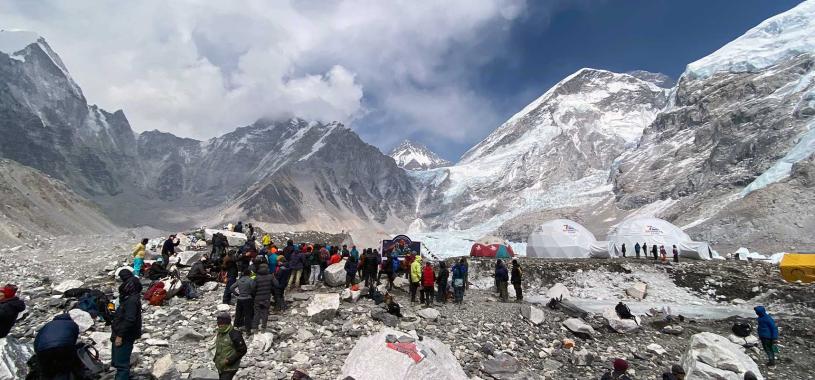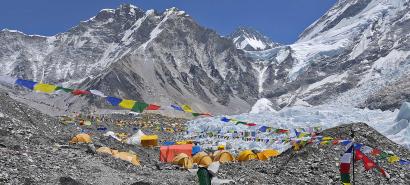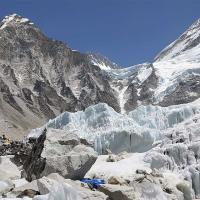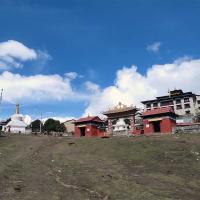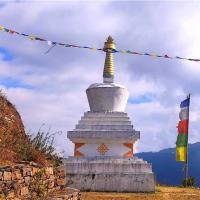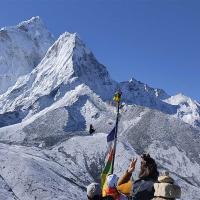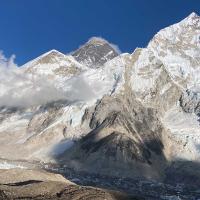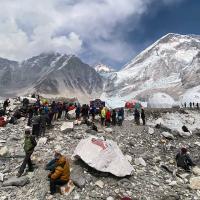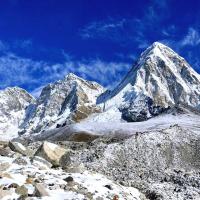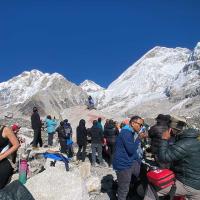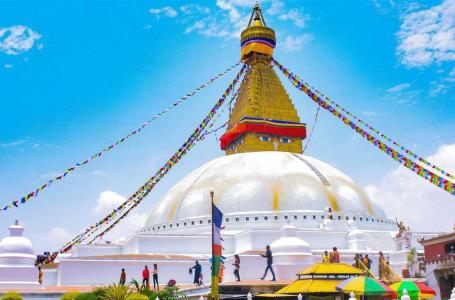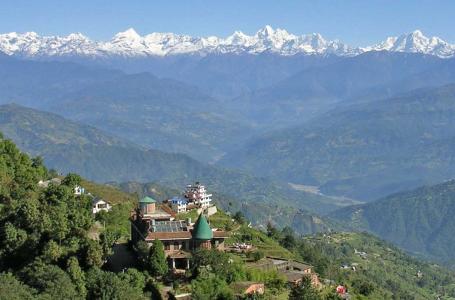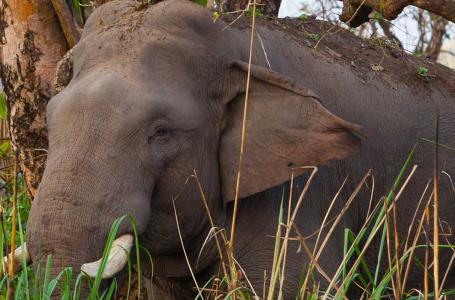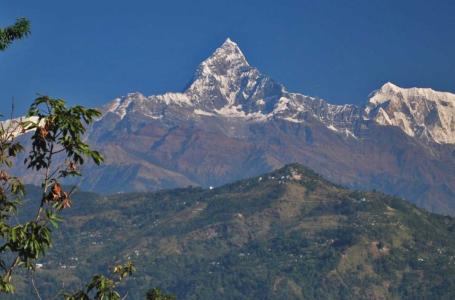- 01Pax USD 1575 pp
- 02 to 05Pax USD 1375 pp
- 06 to 10Pax USD 1175 pp
- 11 to 15Pax USD 1085 pp
Itinerary
As your plane descends into Kathmandu, the views of the entire valley appear intoxicating. Following the visa procedure, you will see one of our representatives, waiting for you at the exit point of the airport, carrying a play card of your name in his hand.
He will welcome you in a traditional Nepalese style with a fresh garland, a warm smile, and a hospitable Namaste. Then, through the winding alleys of Kathmandu, he will guide you to your hotel and help you accommodate in a new environment.
In the evening, you will be introduced to your guide, who will be accompanying you in all the odds and evens during the trek.
Our adventure begins with an exhilarating scenic flight to Lukla, the gateway to the Everest region. The flight offers stunning views of the Himalayan range.
There are two ways to Lukla. First is during peak trekking season you will have to take a flight available from Ramechhap to Lukla. The journey from Kathmandu to Ramechhap takes approximately 5 hours by road, you will need to catch a bus from Thamel around 1.30am. You will reach at Ramechhap airport around 6.30am and then proceed to wait for your flight to Lukla. Second route, during off-peak times, you have the option to fly directly from Kathmandu airport to Lukla.
Upon arrival in Lukla, you'll begin your trek to Phakding. The trail is relatively easy where we will walk along the silent trail, fenced by the farm-fields on both side, and pass by several Mani walls. There are suspension bridges, connecting the two isolated hills, where we will walk through in a hope of encountering a fabulous viewpoint. Consequently, the snowy peak of Kusum Kanguru could be witnessed at some point. Down the village of Ghat, we will finally make an appearance at the Phakding.
This day is one of the challenging days of the whole Everest Base Camp Trek. The trail involves crossing several suspension bridges, including the famous Hillary Suspension Bridge, and a steady uphill climb.
For the first few couple of hours, we will contour around the west side of the Dudhkoshi River and waver up and down along the frequent switchbacks on the trail. On the way, we will encounter a pleasant waterfall at the nice village of Toctoc. We will continue to walk, but just before arriving at the Bengkar, we will see another waterfall at Bengkar. You may as well try the apple pies of this region.
A brief ascent to Monjo will introduce us into the naturally exotic forest of Sagarmatha National Park. There are chances of witnessing the Blue Sheep, but only the luckiest few people have seen the red Panda here.
We will continue through the Jorsalle towards the Namche.
During the final ascent of the forest, there is a viewpoint overlooking the gorgeous views of the Everest. It can only be witnessed on a clear day. A beautiful Kani Gate and a chorten welcome us to the village of Namche.
[Note: Red Panda is a Shy creature. So, it doesn’t show off quite often.]
This is a crucial acclimatization day to help your body adjust to the altitude. Namche is the ancient trading center of Tibet and India. It receives most of the sunlight during the day, distracting the icy cold of the mountains miles away. Plus, there are many side trips branching off from the Namche, making it an ideal spot for acclimatization. Namche Bazaar is a vibrant market town with stunning mountain views, bakeries, and trekking shops.
A historic museum at Namche displays ancient artifacts and extensive cultural monuments of Sherpas. This is a good place to learn about the history of mountains and their connection to the Sherpas. Moreover, a side hill trip at Namche will reward you with the unparalleled views of the Everest and its surrounding peaks.
From Namche, there are two options for an exciting side trip. While one takes you to an amazing viewpoint of Thame, the other one takes you across the quaint monasteries and traditional villages of the Khumjung and Khunde. It is upon you which one to choose. Overnight in Namche Bazaar.
The trail from Namche Bazaar offers spectacular views of Everest and Ama Dablam. It leads off along the right-most trail through the memorial stupa of Tenzing Norgay Sherpa, the first person to summit the mountain Everest with the Sir Edmund Hillary. We will walk through the woods and extrude out into a viewpoint, offering sensational views of the Ama Dablam, Lhotse Shar, Taboche, Kangtega, and Thamserku.
We will continue our journey through the Phunke Tenga. Just before crossing a suspension bridge, there is a line of 7 water-driven prayer wheels, spinning with the pace of the river. One spin of the prayer wheel is similar to chanting the Buddhist Mantra of ‘Om Mane Padme Hum’. It is believed to be the good luck for the passerby.
Within a couple of minutes, we will introduce ourselves into the meadows of Saso Kharka and then, proceed to Tengboche. Here, we'll visit the famous Tengboche Monastery, the largest monastery in the Khumbu region, offering breathtaking views of the surrounding peaks. Overnight in Tengboche.
Early in the morning, we will attend the prayer ceremonies at the Tengboche Monastery and then, explore the monastery. The fine paintings of the Buddha and Guru Rinpoche, hung around the wall, are the masterpiece of traditional artistry of Khumbu region.
From Tengboche, we descend through forests to Deboche and then cross the Imja Khola. The trail gradually ascends to Pangboche, a traditional Sherpa village. We continue our trek through open landscapes, with views of Ama Dablam, to reach Dingboche, a beautiful village in the Imja Valley.
Dingboche is a traditional village, typically with the stone houses, where the farm-fields and settlement area are surrounded by 4 feet (rough estimate) stone walls to protect them from the heavy winds. The people of this village greatly rely on yaks for living, and yak husbandry is their primary profession.
Overnight in Dingboche.
Another important acclimatization day. We'll take a hike to Nangkartsang Peak (5,083m / 16,676ft) for stunning views of Makalu, Lhotse, Cho Oyu, Island peak and other peaks. On the way, we will pay a brief visit to the Nangkar Tshang monastery and continue through the pleasant woods to the top of the hill. While inside the forest, the chirping sound of the birds and insects create a melodious environment, encouraging us to continue our journey.
This hike helps with acclimatization by allowing us to ascend to a higher altitude and then return to sleep at a lower one. Overnight in Dingboche.
(Fun story: At Dingboche, a stone wall, guarding the one side of the field, extends to kilometers of length. According to the locals, this stone wall is the unintentional creation of years of stone deposition. When the farmers plowed their field, they separated the rocks and stones from the soil and kept it on the side of their fields. Later, these stones got piled up one over the other to form a long and beautiful stone wall. The broad base of these walls, somewhat, makes us believe this mythical story.)
Today's trek takes us through the Dughla Pass, where we'll find a memorial to climbers who have perished on Everest. The trail then follows the lateral moraine of the Khumbu Glacier, offering views of Pumori and other peaks, before reaching Lobuche.
In the first part of the journey, we will ascend over the moraine and walk along the ridge, sometimes through the pastures, until we make up to the nice village of Dughla. When we arrive at the Dughla, our second part of the journey begins.
We will proceed along the steep bluffs until making an appearance at the Lobuche. The second part is a bit of a tough climb. Once we are on the Lobuche, the reminiscing views of the Nuptse peak cannot be overlooked. It can be seen from the window of the lodge as well on a clear day.
Overnight in Lobuche.
Certainly, this is the big day as we are about to enter into some of the exquisite viewpoints on earth. But, it is good to control your emotions and go slow on the trail. Otherwise, the altitude may ruin all the good aspects of coming so far to the base camp of the Everest.
Before the darkness is swept by the sunlight, we will proceed to the Gorakshep from Lobuche. It is because in the first few hours of the morning, the pacing icy winds from the glaciers will resist our pace, making our trek more challenging to do.
Once we reach the Gorakshep, we will proceed to the awesome view point of Kalapatthar. This place is so extraordinary that you will have to slap your own cheek to become aware of the reality. The 3600 panorama of the mountains, particularly the Mount Everest, appears sensational. The glaciers and surrounding peaks of the Ama Dablam, Thamserku, and Kantega could be distinctly observed. But, the real animation is brought by the countless tiny anonymous buttresses, which have been guarding the soul of the mountains for ages.
Later, we will descend to the Gorakshep for the overnight stay.
[Note: The sunset view from the Kalapatthar is more exquisite than the sunrise view. Therefore, instead of going to the Everest Base Camp (EBC) (as in customary itinerary), we will go to Kalapatthar on this day.]
This is the most anticipated day of the trek! We start early, to the Everest Base Camp (EBC) to experience the feeling of being on top of the world. The path is slippery, and sometimes, it goes through the narrow bluffs of snow making it difficult to proceed. But, once you are on the base camp of the Everest, the joy is unparalleled.
It is an emotional moment, which in many times becomes a teary moment. But, it is equally inspiring as well. There are camps, set in the base camp by the climbing team of the Everest. In a clear day, the views of the mountains can be fabulous, but nothing in comparison to being on top of the world.
After spending some quality time soaking in the incredible atmosphere, surrounded by the world's highest peaks and the Khumbu Icefall on base of Mount Everest, we will return to the Gorakshep for lunch. After lunch, we will retrace our steps back to Dughla via Lobuche. Instead of proceeding towards the Dingboche, we will head off towards the Pheriche, a quicker option to reach the Namche.
We retrace our steps, descending through familiar landscapes, enjoying the views we might have missed on the way up. The trail leads us back to Namche Bazaar, where you can relax and celebrate the successful completion of your trek to Everest Base Camp. Overnight in Namche Bazaar.
A trek to Lukla takes us along the same trail that we have been earlier.
Finally, we will leave Lukla, as early as possible, over the same intoxicating hills and mountains to finally arrive at Kathmandu. You may as well go for shopping around the markets of Thamel
It’s the end of our exciting journey in the Everest region!
We conclude our thrilling 14 days of Everest Base Camp Trekking and bid you sincere farewell, and hope you’ll travel to majestic, unexplored, and hidden Nepal soon.
Overview
Embark on an unforgettable adventure to the iconic Everest Base Camp, a journey that takes you deep into the heart of the majestic Himalayas. This 14-day Everest Base Camp Trek with Trek Mania Nepal offers a perfect blend of breathtaking landscapes, rich Sherpa culture, and the thrill of standing at the foot of Mount Everest. Follow in the footsteps of legendary mountaineers and immerse yourself in the unparalleled beauty of the Everest region.
Our meticulously planned EBC trek itinerary ensures proper acclimatization, maximizing your safety and enjoyment. Witness panoramic views of towering peaks like Lhotse, Nuptse, Ama Dablam, and of course, Mount Everest itself. Experience the warm hospitality of the Sherpa people, explore ancient monasteries, and traverse picturesque villages nestled amidst stunning mountain scenery. This Everest Base Camp adventure is more than just a trek; it's a life-changing experience that will leave you with memories to last a lifetime.
Everest Base Camp Trek Overview
The Everest Base Camp Trek is one of the most sought-after trekking destinations in the world, attracting adventurers and nature lovers alike. Our 14-day itinerary is designed to provide a comprehensive and safe trekking experience, allowing you to fully appreciate the grandeur of the Everest region. Starting with a scenic flight to Lukla, the gateway to Everest, you'll trek through diverse landscapes, from lush rhododendron forests to barren, high-altitude terrains.
This trek is not just about reaching the base camp; it's about the journey itself. You'll pass through charming Sherpa villages like Phakding, Namche Bazaar, Tengboche, Dingboche, and Lobuche, each offering unique insights into local life and culture. The trail offers continuous views of some of the world's highest peaks, culminating in the awe-inspiring sight of Everest Base Camp (5,364m / 17,598ft) and the panoramic sunrise views from Kala Patthar (5,555m / 18,225ft).
At Trek Mania Nepal, we prioritize your safety and comfort. Our experienced local guides are well-versed in high-altitude trekking and first aid, ensuring a secure and enjoyable journey. We arrange comfortable teahouse accommodations along the trail, providing a cozy retreat after a day of trekking. Join us for an unparalleled Everest Base Camp experience that combines adventure, culture, and natural beauty.
Why Choose Trek Mania Nepal for Your Everest Base Camp Trek?
Choosing the right trekking partner is crucial for a successful and memorable Everest Base Camp adventure. At Trek Mania Nepal, we are committed to providing an exceptional and safe trekking experience. Here’s what sets us apart:
Expert Local Guides: Our guides are highly experienced, government-licensed, and deeply knowledgeable about the Everest region, its culture, and its trails. They are trained in first aid and high-altitude sickness management, ensuring your safety is always the top priority.
Guaranteed Departures: We offer guaranteed departures for our Everest Base Camp Trek, ensuring your trip proceeds as planned.
Personalized Service: We believe in providing a personalized trekking experience. From pre-trek briefings to on-trail support, our team is dedicated to making your journey smooth and enjoyable.
Safety First Approach: Your safety is paramount. We maintain strict safety protocols, including proper acclimatization schedules, regular health checks, and access to emergency support.
Responsible Tourism: We are committed to sustainable and responsible tourism practices, ensuring our treks benefit local communities and preserve the natural environment of the Himalayas.
Comprehensive Support: From airport transfers to quality accommodation and meals, we handle all logistics, allowing you to focus solely on your trekking adventure.
Transparent Pricing: Our packages are all-inclusive with no hidden costs, providing excellent value for your investment.
Planning the Everest Base Camp Trek:
Trekking to Everest Base Camp (EBC) is an exciting activity that requires meticulous planning to ensure a safe and memorable expedition. To begin, choose the appropriate season and check you have the proper licenses. Similarly, planning a well-thought-out itinerary is critical, including acclimatization days to reduce altitude-related dangers. You can hike with a friend or with the aid of local guides and porters for navigation and support.
Warm clothes, a sleeping bag, and waterproofs are required but pack effectively to save weight. Likewise, physical fitness and altitude training should be part of your pre-trek preparations, and complete travel insurance for medical emergencies and evacuation is required. Responsible hiking that adheres to Leave No Trace principles and respects local customs adds to the region's sustainable tourism.
By following these necessities, you are ready to have fun on your trip to one of the world's most famous trekking destination!
The best time to do the Everest Base Camp Trek?
During the autumn season (September to November) is ideal for this Everest Base Camp Trek. The weather is warm, and your boots' grip on the frozen terrain may hold, making it simpler for us to climb. In addition, during these months, you might look for a group (any trekker) to accompany you throughout the trip.
The spring season (March, April, and May) is also ideal for hiking, however, there is a risk of avalanches.
Monsoon and summer seasons (June, July, and August) are not ideal for an Everest Base Camp trek. Likewise, the cold of winter (December, January, and February) is intolerable for the average trekker.
Foods and Accommodations during EBC Trek:
During our Everest Base Camp trek, you will stay in teahouses, which are basic but comfortable, clean and cozy lodges along the route. Rooms are twin-sharing with warm blankets, common dining areas and sometimes shared bathrooms. Facilities become more basic as you ascend to higher altitudes. At Trek Mania Nepal, we handpick the best lodges to ensure quality service, hygiene, and comfort at high altitudes.
Teahouses offer a variety of meals, including traditional Nepali dishes (Dal Bhat is a staple), pasta, noodles, and soups. Coffee, tea and drinks are available in some places in the mountain but can be expensive, In some places even water may not available in the trek during walking except for restaurants and cafe. So, you have to carry extra water for day time.
Important Lukla Flight Information:
The flight to Lukla (Tenzing-Hillary Airport) is an integral part of the Everest Base Camp Trek. These flights are highly dependent on weather conditions in the mountains, and delays or cancellations are common. We advise all trekkers to be prepared for potential disruptions.
Kathmandu to Lukla Flights: During peak trekking seasons (March-May and September-November), flights to Lukla often operate from Ramechhap (Manthali Airport) instead of Kathmandu's Tribhuvan International Airport due to air traffic congestion. This requires a bus ride (approx. 5-6 hours) from Kathmandu to Ramechhap.
We will then take a direct flight from Rameechap Manthali Airport to Lukla Airport. If you want to travel by private vehicle to Ramechhap, an additional cost of USD 100 must be paid. In terms of flight time, Travellers should plan to check out at about 1 a.m. for the same-day flight.
If you opt to remain one night in Rameechap for the same-day flight, you will be charged an additional amount for the hotel, which will be approximately USD 20 per person. During off-peak seasons, flights typically operate directly from Kathmandu.
Weather Dependency: Flights to and from Lukla are strictly visual flights (VFR) and can be delayed or canceled due to adverse weather conditions (fog, strong winds, rain).
Buffer Days: We highly recommend allocating at least 1-2 extra buffer days in your itinerary before and after your trek to account for potential flight delays. This helps prevent missing international flights or disrupting your travel plans.
Alternative Options: In case of prolonged flight cancellations, helicopter charters are an alternative, though at an additional cost. Our team will assist you with the best available options during such situations.
Your safety and timely travel are our priority. Our team will keep you informed about flight statuses and assist with any necessary arrangements.
Moreover, if you would like to escape the Lukla flight and embark on the Classic Everest Base Camp Trek route, there is an option to trek to Everest Base Camp via Jiri.
Necessary Permits & TIMS:
In order to visit the territory, Everest requires three sorts of permits. A Trekker's Information Management System (TIMS) Card is no longer required. These permissions can only be obtained from licensed agencies, and no freelancing guide can give them.
Khumbu Pasang Lhamu Rural Municipality Entrance Permit:
This permit is intended to supervise and handle tourism activity in the Khumbu region. It is necessary across the Khumbu region, including Namche Bazaar, Tengboche, Dingboche, and Gorakshep, and is valid till Jiri.
Cost: NPR 3000 Per Person for each foreigner.
Sagarmatha National Park Entry Permit:
The purpose of this permit is to restrict and manage entry to the Sagarmatha National Park in order to preserve its natural beauty and biodiversity. The cash collected by these permits is utilized to conserve and maintain the park.
Cost: NPR 3000 Per Person for each Foreigner
Additional Permit for Jiri to Everest Base Camp Trek:
While entering EBC via Jiri, an extra permit for the Gaurishankar Conservation Area is required till we reach the Everest Base Camp Trek.
Cost: NPR 3000 Per Person for each foreigner.
(All the permits required are included in this package).
Necessary documents for Permits:
You will only need your valid passport photocopy (validity of 6 months).
Highlights
- Majestic Mount Everest
- Sherpa Culture and Ethics
- Strenuous Trekking Route
- Kalapatthar- majestic viewpoint
- Tengboche Monastery
- Nepal’s biggest Khumbu and longest Ngozumpa glaciers
- Hillary Museum
- Sagarmatha National Park
- Traditional Sherpa villages, culture, traditions & hospitality
Cost Details
- Airport transfers upon arrival and departure in Kathmandu.
- Hotel in Kathmandu. (Hotel Chhimeki 2night)
- All All standard meals and accommodation during the trek.
- Transportation costs: Comfortable Drive from Hotel to Airport to Hotel.
- Round-trip domestic flights: Kathmandu/Ramechhap - Lukla - Kathmandu/Ramechhap.
- Experienced, English-speaking, government-licensed trekking guide.
- All necessary trekking permits (Sagarmatha National Park Entry Permit, Khumbu Pasang Lhamu Rural Municipality Entrance Fee).
- First aid medical box.
- T-shirt, Duffel Bag, and Trekking Map.
- Rescue Management Service.
- All Government Taxes 13% VAT+10% Service charge.
- Farewell Dinners
- All kinds of Drinks.
- Nepal Entry Visa fee (can be obtained upon arrival).
- International airfare to and from Kathmandu.
- Extra night accommodation and meal costs in Kathmandu due to any change in the scheduled itinerary
- Travel insurance (mandatory, including high-altitude rescue).
- All required trekking gear like sleeping bags and down jackets made available on rent.
- All personal expenses (laundry, electronic device. charging cost)
- Tips for guides and porters.
- Hot and cold Shower.
- Any expenses incurred due to unforeseen circumstances (e.g. natural disasters).
Trip Map
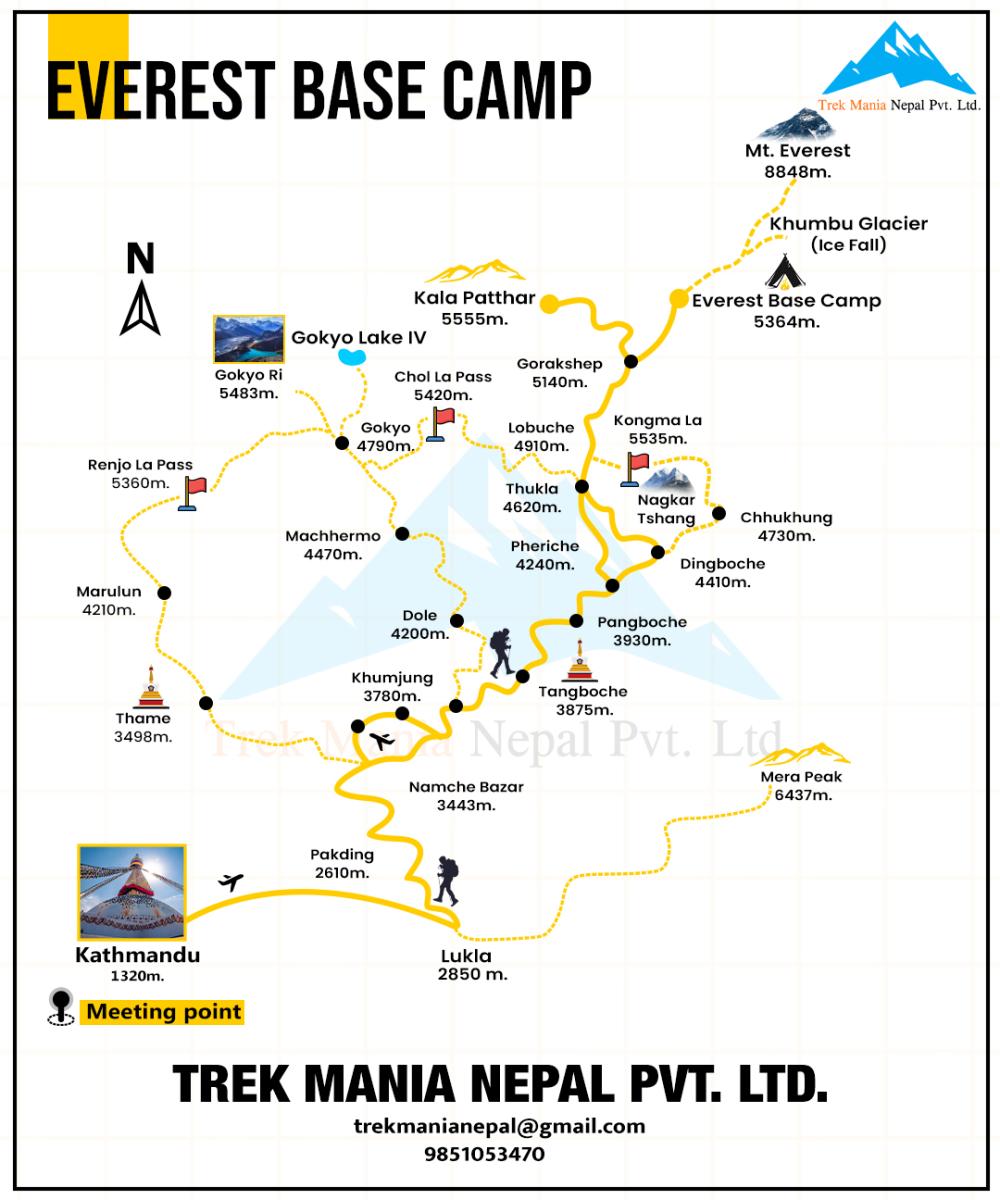
Dates & Pricing
Trip Start and End Point
Kathmandu / Kathmandu
| DATES | STATUS | PRICE | SPACE LEFT | ||||
|---|---|---|---|---|---|---|---|
|
Start date: 05-Dec, 2025
End date: 18-Dec, 2025 |
Guaranteed | USD 1575 |
3
|
Book Now | |||
|
Start date: 13-Dec, 2025
End date: 26-Dec, 2025 |
Guaranteed | USD 1575 |
2
|
Book Now | |||
|
Start date: 15-Mar, 2026
End date: 28-Mar, 2026 |
Guaranteed | USD 1575 |
3
|
Book Now | |||
|
Start date: 17-Mar, 2026
End date: 30-Mar, 2026 |
Guaranteed | USD 1575 |
2
|
Book Now | |||
|
Start date: 26-Apr, 2026
End date: 09-May, 2026 |
Guaranteed | USD 1575 |
1
|
Book Now | |||
|
Start date: 05-May, 2026
End date: 18-May, 2026 |
Guaranteed | USD 1575 |
1
|
Book Now | |||
|
Start date: 05-Jun, 2026
End date: 18-Jun, 2026 |
Guaranteed | USD 1575 |
1
|
Book Now | |||
|
Start date: 18-Jun, 2026
End date: 01-Jul, 2026 |
Guaranteed | USD 1575 |
2
|
Book Now | |||
|
Start date: 27-Jul, 2026
End date: 09-Aug, 2026 |
Guaranteed | USD 1575 |
1
|
Book Now | |||
|
Start date: 15-Aug, 2026
End date: 28-Aug, 2026 |
Guaranteed | USD 1575 |
3
|
Book Now | |||
|
Start date: 19-Aug, 2026
End date: 01-Sep, 2026 |
Guaranteed | USD 1575 |
2
|
Book Now | |||
Equipment List
- Woolen shirts and thick sweaters.
- Jackets (Fiber or down).
- Waterproof jacket with hood or poncho.
- Tracksuit, Track shoes, and Trousers.
- Thermal Underwear and Thermal Coat.
- 2 pairs of loose-fitting long shorts/ skirts.
- Pair of Gloves and sandals.
- Woolen hat and long-sleeved shirt.
- Lightweight walking boots.
- 2 pairs of thin socks and 2 pairs of woolen socks & neck gaiter.
- Snow glasses and sunglasses.
- Trekking Sticks and Duffle bag or kit bag to carry to gear while trekking.
- Some (small/large) plastic bags to separate clean clothes from dirty ones and some smaller plastic bags to dispose of garbage.
- Daypack bag to carry your personal requirements.
- Water Bottle, water purifying tablets.
- Towels, Umbrella (optional).
- Headlamp, Binoculars, Camera, trekking map and compass, reading materials, pencil, rubber, pen, notebook & moisturizer for lip, face body.
FAQs
The Everest Base Camp (EBC) trek is a moderate to challenging journey, requiring 5 to 7 hours of daily trekking on rugged mountain trails. While prior trekking experience helps, beginners with good fitness levels and proper preparation can complete it. At Trek Mania Nepal, we provide expert guides, personalized itineraries, and acclimatization plans to make your adventure safe and enjoyable.
The best seasons for the Everest Base Camp Trek are spring (March-May) and autumn (September-November). These months offer stable weather, clear mountain views, and pleasant temperatures. Trekking during winter is possible but requires extra gear for extreme cold. With Trek Mania Nepal, we help you plan your trek during the best conditions for a smooth and breathtaking adventure.
During our Everest Base Camp trek, you will stay in teahouses, which are basic but comfortable, clean and cozy lodges along the route. Rooms are twin-sharing with warm blankets, common dining areas and sometimes shared bathrooms. Facilities become more basic as you ascend to higher altitudes. At Trek Mania Nepal, we handpick the best lodges to ensure quality service, hygiene, and comfort at high altitudes.
Teahouses offer a variety of meals, including traditional Nepali dishes (Dal Bhat is a staple), pasta, noodles, and soups. Coffee, tea and drinks are available in some places in the mountain but can be expensive, In some places even water may not available in the trek during walking except for restaurants and cafe. So, you have to carry extra water for day time.
Yes, acclimatization is extremely important. Our itinerary includes dedicated acclimatization days in Namche Bazaar and Dingboche to help your body adjust to the increasing altitude, significantly reducing the risk of acute mountain sickness (AMS).
Yes, high-altitude travel insurance is mandatory for EBC treks. Your insurance should cover emergency evacuation, medical expenses, and trip cancellations. At Trek Mania Nepal, we assist in choosing the right insurance policies and offer 24/7 emergency support to ensure a safe and worry-free trekking experience.
Along with the daypack with your essentials (water, snacks, camera, extra layers), you can expect to carry the main luggage weight of around 10-15 kg per person. Porter assistance in carrying the main luggage can be obtained with a extra fee of around $15-$20 per day. Let us know prior if you need a porter.
Our group sizes are typically small, ranging from 2 to 8 trekkers. This allows for a more personalized experience and better group dynamics. Private treks can also be arranged.
Kala Patthar (5,555m / 18,225ft) is a prominent viewpoint near Gorak Shep. It offers the most spectacular panoramic views of Mount Everest, Lhotse, Nuptse, and the surrounding Himalayan range, especially during sunrise. It's a key highlight of the EBC trek.
Yes, most teahouses offer charging facilities for electronic devices, usually for a small fee. It's advisable to carry a power bank for convenience, especially at higher altitudes where electricity can be less reliable.
Your experienced guide will lead the trek, manage logistics, ensure your safety, and provide insights into the local culture and mountains. Porters carry your main luggage, allowing you to trek with a lighter daypack. Both play crucial roles in your trekking experience.
Nepali Rupees (NPR) are used. It's advisable to carry enough cash for personal expenses, as ATMs are scarce beyond Namche Bazaar.
Travellers Review
Professional and well organised
Trekmania provided an exceptional trekking experience in Nepal. Their organization, personalized service, and commitment to safety were outstanding. The breathtaking landscapes, knowledgeable guides, and cozy accommodations surpassed all expectations. I was impressed by their dedication to responsible tourism and sustainability. If you’re seeking an unforgettable adventure in Nepal’s majestic Himalayas, choose Himalayan Treks without hesitation. You won’t regret it!
Unforgettable memories for lifetime on Everest
I enjoyed the travel more than I ever expected. My trekking guide, Ram, was witty, funny, and incredibly optimistic. His smile constantly pushed me to achieve the higher heights of Everest (such support is extremely important if you wish to make it up to the base camp). Based on my experience, Trek Mania was the wisest decision that I have made. Will be back very soon, Devraj!


